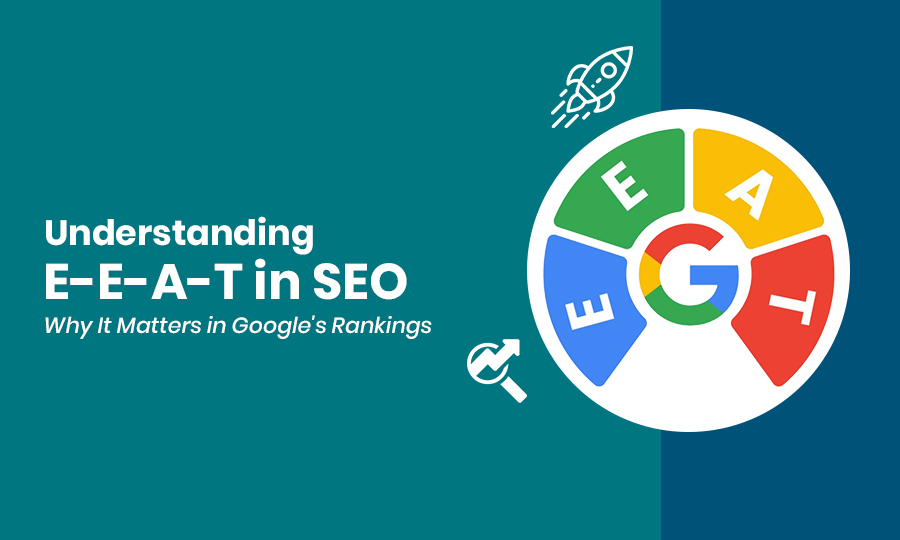Since 93% of all online experiences start with a search engine result, and 86.06% of global traffic comes from Google Search, you have to show your expertise, authoritativeness, and trustworthiness. That’s why Google introduced Google e-e-a-t in December 2022. It is the most significant ranking factor for your website on Google.
As a business owner, you always want your website to rank at the top of Google’s first page. To hold first-page rankings is not always easy; you need to follow Google’s search quality rater guidelines. Most of the blogs miss this specific ranking factor of Google. When you create quality content according to this Google E-E-A-T—Experience, Expertise, Authoritativeness, Trustworthiness—it signals search engines that your content quality is high and ready for the highest ranking.
So, you are required to find out how you represent E-E-A-T in your content. In this writing, you will discover all the necessary factors for E-E-A-T in SEO (search engine optimization) and how to create reliable resources for a brand and the best example of websites incorporating E-E-A-T. Let’s get started—
What Is Google E-E-A-T, and How Did It Evolve From E-A-T?
Google E-E-A-T stands for Experience, Expertise, Authoritativeness, and Trustworthiness. The earlier E-A-T model is expanded by Google E-E-A-T, which highlights reliable information that supports accurate data. Google’s quality rater guidelines use E-E-A-T as a lens for checking page quality and search performance. High E-E-A-T content is more likely to rank well in search results. However, Google introduced these rules only to inform search engines.
The Four Pillars Breakdown
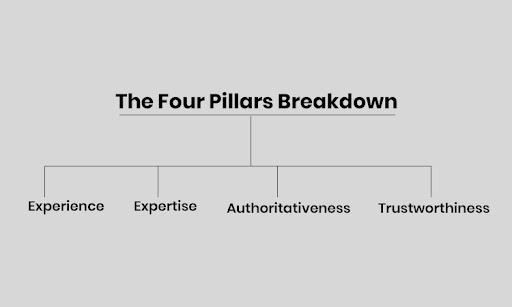
- Experience: First-hand, lived experience with topics
- Expertise: This demonstrates adequate expertise and knowledge, and skills
- Authoritativeness: Recognition within the field
- Trustworthiness: Reliability and transparency
Timeline of Google’s Algorithm Updates (2018 to Present)
- The August 2018 broad core update, often called “Medic,” drew industry attention to E-A-T signals, especially on sensitive topics.
- Core changes in 2019 and later made the focus even more on value and trustworthiness.
- Reviews that show detail and proof were awarded in the 2021–2022 product review changes. The helpful content update from August 2022 prioritized intent-satisfying, people-first content.
- In November 2022, Google made its ranking systems publicly accessible to make clear how features like reviews, core updates, and helpful content operate.
The Addition of “Experience” in December 2022
In December 2022, Google added the extra E for experience to the rater guidelines to point out life experience, firsthand use, or observation as a unique quality signal. According to Google’s announcement, raters use the E-E-A-T method to determine how well results represent reputable sites and other authoritative websites. Ratings are not ranking factors; rather, they indicate how well search ranking systems are working.
How E-E-A-T Differs Across YMYL (Your Money, Your Life) Topics
YMYL topics such as health, finance, and safety get the most attention because users need reliable information with clear instances of expertise and authoritativeness. Google’s guidelines stress that experience is especially important for YMYL topics. The guidelines remind quality raters to consider the legitimacy of sources, the track record of authors, and the presence of solid verification from other authoritative sites. Low-quality ratings should be given to pages that don’t have the right E-E-A-T for their intent. This shows that search performance may suffer if you present false information as high-quality.
Why Do Experience, Expertise, Authoritativeness, and Trustworthiness Matter for SEO Success?
You should know about E-E-A-T because it has a direct effect on search engine optimization by changing how algorithms evaluate content. Google’s search quality raters assess content based on the extent of the creator’s experience related to the topic. E-E-A-T signals are a key part of Google’s ranking system. They are used to train machine learning systems with feedback from quality raters.
- E-E-A-T is particularly important for topics that can significantly impact a person’s life, such as health and finance.
- Google emphasizes that trust is the most critical component of E-E-A-T, as untrustworthy content has low E-E-A-T.
- Low-quality pages with E-E-A-T are often rated as untrustworthy and may not be used as quality resources by Google.
So if you want higher rankings in Google, you need to implement E-E-A-T prominently.
- The Foundation of Modern Search Rankings- Google’s search quality raters examine billions of web pages based on the search quality rater guidelines to figure out what defines quality content. These human evaluators assess how well each blog post and webpage displays Experience, Expertise, Authoritativeness, and Trustworthiness (E-E-A-T).
- Critical Ranking Factor Impact- E-E-A-T is a significant ranking factor that affects how Google algorithms test the content quality. The quality rater guidelines tell reviewers exactly what to look for: real expertise and real-world experience in the topic area of the content.
- Building Authority Through Trust Signals- When websites show strong E-E-A-T signals, they naturally get high-quality backlinks from legitimate sources. The site’s overall authority and financial stability in competitive markets are enhanced through the integrity of its content.
- Beyond Traditional SEO Metrics- Effective E-E-A-T is a big step toward human-centered content evaluation, even though technical optimization is still important. Real expertise is more important to quality raters than keyword density. This ensures that users get accurate information that answers their questions and meets their needs.
Which Industries Need Stronger E-E-A-T Signals Than Others?
Some specific industries need greater expertise, authoritativeness, and trustworthiness signals. Because they have a direct impact on users’ lives and the financial well-being of people. Search engines and users focus more on brand reputation and reliability in these sectors, which often involve YMYL pages (Your Money or Your Life).
- Healthcare and medical industries- The first ones on the list are healthcare and medical, where you cannot produce any misinformation. Then it will make life-threatening for people. So most of the medical websites must establish subject matter expertise through licensed professionals. Then they have to connect with reputable websites like medical journals and health institutions. That’s why they need authoritative sources with clear author credentials.
- Financial services and investment- It handles delicate financial data and investment advice that directly affects users’ financial stability. These sites need regulatory compliance, professional certifications, and partnerships with financial institutions to show E-E-A-T.
- Legal and government sectors- This sector needs to be very trustworthy because it gives legal advice and official information. Legal firms and government agencies must show their knowledge and authoritative or trustworthy source through their case histories, bar certifications, and official government affiliations.
- Education and certification bodies- One of the most important sectors to establish brand reputation through alumni success stories and industry acceptance. It shapes career paths and learning outcomes, so you need to have strong ties to reliable websites and recognized organizations.
- Technology and software reviews-You can have an effect on business decisions and purchases. To keep their content trustworthy, tech review sites need competent reviewers who know a lot about the subject and who can verify techniques that are easy to understand.
Industry-Specific E-E-A-T Building Strategies
- Professional certification showcasing- You have to create strong E-E-A-T signals, which requires targeted approaches for each industry. When you show your professional certificate, it helps establish your experience expertise, authoritativeness.
- Industry association memberships- Thereafter, you can increase the brand authority to link your websites and authoritative sources in your field. These partnerships show search engines and users that your brand follows the rules of the industry.
- Speaking engagements and conference participation-Then you need to give them ways to use thought leadership and expert positioning to show they are E-E-A-T. This advances the brand’s reputation and develops prospects for useful content.
- Peer recognition, media mentions, and press coverage cultivation- Moreover, you can acquire reliability through third-party validation, while media mentions and press coverage cultivation create connections with authoritative sources and grow your digital footprint across reputable websites. This can help establish your brand as a trusted and reputable source in your industry.
Where Do Google’s Quality Raters Evaluate E-E-A-T Signals?
Google’s quality raters review websites carefully across multiple touchpoints to see how experienced, knowledgeable, authoritative, and trustworthy they are. They are like the human brains behind the company’s search algorithm improvements.
- Quality Rater Guidelines Deep Dive
There are 175 pages of guidelines that quality raters use to evaluate web pages. These are called the search quality rater guidelines. The rating guidelines tell raters to carefully look at:
Initial Page Assessment
- Quality of Main Content (MC): Raters check to see if the content shows real expertise and offers a lot of value.
- Author/Website Information: Verification of author credentials and website authority
- Reputation Research: Investigation of what other authoritative sources say about the website or content creator
- E-E-A-T Evaluation Framework
- Experience Assessment: Does the author demonstrate firsthand experience with the topic?
- Expertise Verification: Are credentials, qualifications, and knowledge depth evident?
- Authoritativeness Check: Is the website recognized as a go-to source in its field?
- Trustworthiness Analysis: Can users rely on the information for important decisions?
- On-Page E-E-A-T Signals That Raters Examine
Quality raters examine specific on-page elements that signal expertise and trustworthiness:
Content Quality Indicators
- Coverage: The topics you write about should be covered in depth, and you should include sophisticated perspectives.
- Accuracy and Fact-Checking: Correct citations, updated data, and revisions for errors.
- Original Research: Unique data, case studies, or proprietary insights.
- Clear Source Attribution: Proper crediting of external information and statistics.
Author Authority Signals
- Full author biographies with complete work histories, qualifications, and experience.
- Photo of the author and contact information: signs of authenticity and availability.
- Byline Consistency: You have to correct author credit in a wide range of high-quality documents.
- Integration of social proof: Awards, honors, and professional successes.
Content Structure Analysis
- Headlines and Subheadings: Your headings should be clear, descriptive, and topic-relevant.
- Internal Linking Patterns: Hyperlinks that make sense to related, legitimate content.
- Update timestamps: Dates of recent release or change that show how relevant the information is right now
- The contact and about pages give you a lot of information about your business and are open and honest.
- Off-Page Authority Indicators
Domain Authority Assessment
- Industry Recognition: Mentions in trade publications, news outlets, and professional forums
- Expert Citations: References by other authoritative figures in the field
- Media Coverage: Press mentions, interviews, and thought leadership features
- Professional Associations: Memberships in relevant industry organizations
Link Profile Evaluation
- High-Quality Backlinks: Links from educational institutions, government sites, and industry leaders
- Editorial Links: Natural mentions in relevant content contexts
- Guest Contributions: Published work on authoritative platforms
- Speaking Engagements: Conference presentations and industry event participation
Reputation Verification Process
- Search Engine Research: Google searches for the website, brand, and key personnel.
- Review Platform Analysis: Better Business Bureau, Trustpilot, and industry-specific review sites
- Social Media Presence: Professional profiles and community interaction quality
- Third-Party Validation: Independent verification of representations and authority
- User Behavior Metrics and Engagement Signals
Even though quality raters don’t have direct access to analytics data, they do look at signs of user satisfaction, such as:
Engagement Quality Indicators
- Content Depth Consumption: Evidence that users read beyond headlines
- Comment Quality: Thoughtful discussions and expert responses in comment sections
- Social Sharing Patterns: Quality of social media engagement and shares
- Return Visitor Behaviors: Indicators that users find ongoing value
User Experience Factors
- Page Load Speed: Technical performance that supports a positive user experience
- Mobile Responsiveness: Proper display and functionality across devices
- Navigation Clarity: Intuitive site structure and clear user pathways
- Accessibility Features: Inclusive design that serves diverse user needs
- Technical SEO Factors That Support E-E-A-T
Security and Trust Indicators
- SSL Certificates: Secure connection protocols for user safety
- Privacy Policy Compliance: Clear data handling and user rights information
- Terms of Service: Transparent business practices and user agreements
- Contact Information Accuracy: Verified business addresses, phone numbers, and email contacts
Technical Validation Checklist
- Website Security: HTTPS implementation and security certificate validity
- Contact Verification: Working contact forms, phone numbers, and physical addresses
- Legal Compliance: Privacy policies, terms of service, and regulatory disclosures
- Professional Presentation: Error-free content, consistent branding, and polished design
Content Management Systems
- Regular Updates: Fresh content publication and existing content maintenance
- Error Handling: Proper 404 pages and redirect management
- Site Architecture: Logical URL structure and clear content categorization
- Schema Markup: Structured data that helps search engines understand content context
How to Build Authoritative Sources and Brand Reputation for E-E-A-T?
Your ability to be seen as an authoritative or reliable source in your field is very important for having a good Google E-E-A-T profile. So you have to attract high-quality backlinks to dominate users’ searches. According to Google’s search quality rater guidelines, trustworthy content from authentic sites improves search rankings. Here you can get to know the step-by-step approach to develop reputable sources and search visibility to extend your SEO success.
- Internal Linking to Demonstrate Topical Depth
Internal linking informs Google’s search engine rankings system that your web page has all the adequate expertise that matches Google E-E-A-T signals. In this approach, you have interlinked all relevant pages within your website to show the depth of your knowledge on a particular topic. Moreover, you can create a topic cluster, which shows both users and search quality raters that your site has valuable content.
How to do it:
- Identify Core Topics—First, you need to select main concepts relevant to your content strategy (e.g., “YMYL pages” for finance or health sites).
- Create Supporting Content—After that, you can write several high-quality content about each topic that cover different subtopics.
- Link Contextually—While writing your content, include internal links to other relevant web content with anchor text that sounds natural and describes the page.
- Use a Hub Structure—SEO-wise, your site’s authority will go up if you have a main “pillar” page that links to other pages that are related.
Best Tools to Optimize Internal Links:
- Ahrefs Site Audit—It finds neglected pages and suggests relevant opportunities for internal linking.
- Screaming Frog SEO Spider—Explores your website to find broken links and disorganized anchor text.
- Link Whisper (WordPress plugin)— While you’re writing, AI makes contextual internal link suggestions.
- SurferSEO Audit—Moreover, you can analyze internal link structure as well as keyword placement for SEO success.
- Yoast SEO Premium—Points out available linking options in the WordPress editor.
For those looking for professional assistance beyond tools, consider affordable link building services to enhance your website’s SEO and authority.
When the site owners execute a clear linking strategy with these tools, they enhance topical depth, improve search visibility, and expand the metrics Google uses to assess expertise, authoritativeness, and trustworthiness.
- External Citation From Reputable Sources
The quality raters and algorithms at Google will see that your content is credible and based on accurate information if you link to other trustworthy websites.
How to do it:
- Research Authoritative Sources—You can use keyword research tools to find top-ranking authoritative resources for your niche.
- Cite Data and Statistics: Always provide hyperlinks to reputable sources, such as official government publications, scholarly journals, or well-known business executives, to support your statements.
- Keep Your Sources Up to Date: Replace old citations with current research or reliable websites to improve the quality of your content.
- Keep External and Internal Links in Balance: Moreover, you have to ensure external links complement your overall quality content rather than detract from it.
Best Tools for External Citation Optimization:
- BuzzSumo (identify high-performing reputable sources)
- Google Scholar (academic and scientific citations)
- Guest Posting on Industry-Leading Sites
It is helpful for your brand’s authority and search visibility to have your content published on other reputable websites. This is called earning high-quality backlinks through guest posting. Guest posting on industry-leading sites can also help you reach a wider audience and drive more traffic to your website.
How to do it:
- Identify Target Sites—You need to search for industry blogs with strong search engine rankings and a history of producing quality content.
- Pitch value-driven ideas—then you can come up with different topics where you can demonstrate E-A-T and seem intelligent and legitimate.
- Showcase Your Expertise—To develop yourself as an expert, you should share case studies, personal experiences, or original research.
- Put in contextual links—This will help you earn quality backlinks from reputable sites in your industry, which can improve your own website’s search engine rankings. Furthermore, engaging with the audience on these industry-leading sites through comments and discussions can further create your validity and expertise.
- Thought leadership content development
If you want to enhance your brand’s reputation and search performance, you should write trustworthy content that makes you a thought leader. Google aims to endorse accurate content that provides unique perspectives rather than generic advice.
How to do it:
- Explore New Topics—You need to talk about new developments in your niche before your competitors do.
- Offer Actionable Insights – Go beyond theory—give readers exact steps, tools, or frameworks.
- Expert Collaboration: You have to develop blog posts or web content with other well-known content creators in the same field.
- Take Care When Using AI Tools—You can take advantage of AI tools for research and writing, but make sure that a person checks the quality of the work to ensure it meets quality standards.
- Community building and engagement strategies
A loyal audience helps a brand’s online presence and indicates to Google’s search quality raters that the brand is genuine. After that, you can join communities that create a lot of user-generated content and word-of-mouth that can help your site rank higher.
How to do it:
- Start a Forum or Social Group—Generate spaces where users can share personal experiences related to your niche.
- Deal with Questions or Problems—You need to solve them, even if they’re just about basic customer service information.
- Get reviews and testimonials—Next, you need to get positive reviews on trustworthy websites to improve the reputation of your brand.
- Host Webinars or Live Q&As—Moreover, you can interact directly with your audience, which raises trustworthy content perception.
Top 5 Advanced Brand Authority Tactics
One of the best ways to improve your SEO results and have long-term SEO rankings is to develop a strong brand authority. Google’s quality rater guidelines highlight that expertise, authoritativeness, and trustworthiness (E-E-A-T) are significant signals for search ranking systems.
- Wikipedia Presence and Citations
A Wikipedia page is often seen as a badge of reliability because it requires references from reputable sources and other authoritative sites. Even though Google’s authoritative raters don’t use Wikipedia as a direct ranking factor. However, it can help your search engine rankings in other ways by increasing online brand exposure.
How to do it:
- Check your brand’s notability:You have to make sure it meets Wikipedia’s criteria for notability by getting coverage from trustworthy websites.
- Gather citations: utilize reliable sources such as industry publications, interviews, and accolades. Create or edit a page:If eligible, submit a well-sourced draft through Wikipedia’s community review.
- Maintain accuracy: Your content should be more authentic and informative than your competitors’ content.
- Google Knowledge Panel Optimization
A Google Knowledge Panel immediately improves a brand’s online reliability in search results. It integrates data from authoritative sites, reputable sources, and structured web content. An optimal ranking panel signals adequate expertise and overall quality to search engines.
How to do it:
- Claim your panel:Search your brand name, then click “Claim this knowledge panel” if available.
- Verify your identity:Use official brand accounts to confirm ownership.
- Add complete details:Ensure your site, social profiles, and all the required documents are accurate.
- Feed consistent data: Use schema markup on your own content to help Google pull correct facts.
- Industry Publication Contributions
When you publish in trade magazines, you develop yourself as an acknowledged expert in your field and a reliable source. It also helps you get good rankings and makes your site more trustworthy.
How to do it:
- Research outlets: You ought to target reputable sites in your niche.
- Pitch valuable content: Then you can offer high-quality resources that show experience, expertise, and authoritativeness.
- Show credentials: Include bios of the authors that indicate adequate knowledge to uphold accuracy.
- Link naturally: Earn links to helpful content or your own content without appearing promotional.
- Podcast And Video Content Authority
Creating content through podcasts and videos showcases personal experiences, subject matter expertise, and real-world knowledge. These formats allow content creators to connect with audiences in ways text alone cannot.
How to do it:
- Pick a niche: You have to pay attention to subjects where you can show E-A-T with reliable writing.
- Make a content strategy: Write out episodes or videos that give useful advice and accurate information.
- Distribute widely: Advertise on YouTube, Spotify, Apple Podcasts, and embed on web pages.
- Social Proof and Testimonial Integration
Social proof gives users and search quality raters optimism in the authority or reliability of your brand. Testimonial integration can also help to build trust and credibility with potential customers.
How to do it:
- Collect testimonials: You can ask for comprehensive input from satisfied customers.
- Showcase clearly: Place reviews on landing pages and YMYL pages to support claims of high-quality content.
- Use reputable platforms: Then you can collect feedback on Google Business Profile, Trustpilot, or other platforms.
- Highlight results: Incorporate indicators or transformations to prove overall quality.
The 5 Most Important Real-World Examples of E-E-A-T Implementation
You need to learn from real-world website examples, and then your thoughts will be clearer.
- Dogster
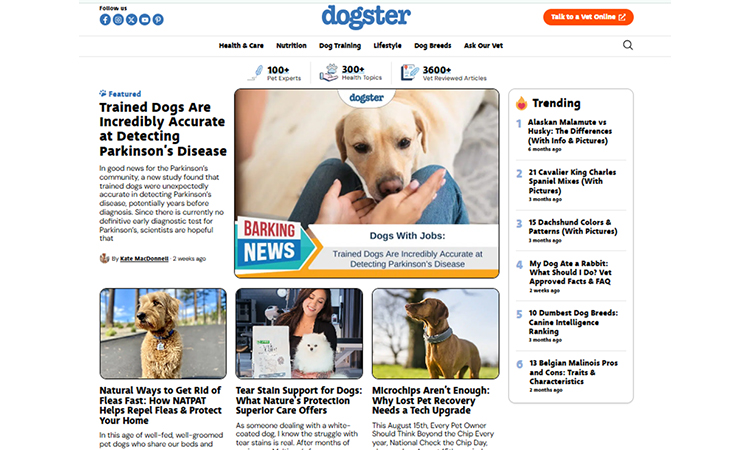
Dogster has Experience, Expertise, Authority, and Trustworthiness. The website has a lot of articles written by licensed veterinarians and certified dog trainers. These articles offer real-life examples and veterinary knowledge. From Google’s perspective, it stands out for its transparent citations, author bios, and clear credentials.
- GadgetMates
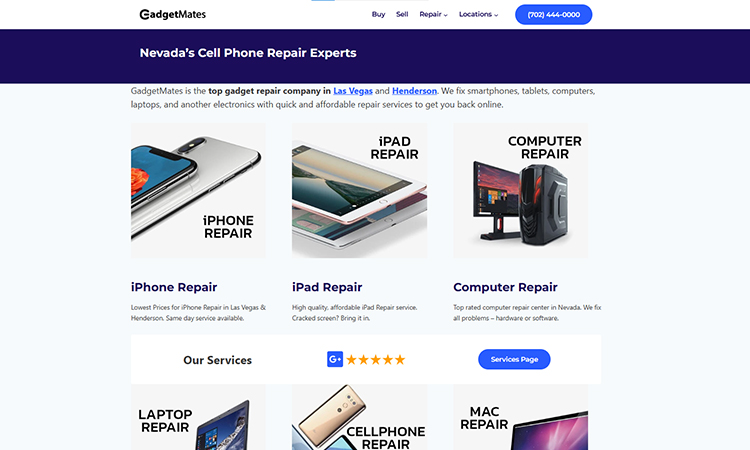
GadgetMates is a brand that fixes electronics and has stores. They do a great job with E-E-A-T by showing real repair experience. It has step-by-step instructions, repair photos, and troubleshooting information on its website. Transparent contact information, customer reviews, and policies further cement trust.
- Homesteading Family
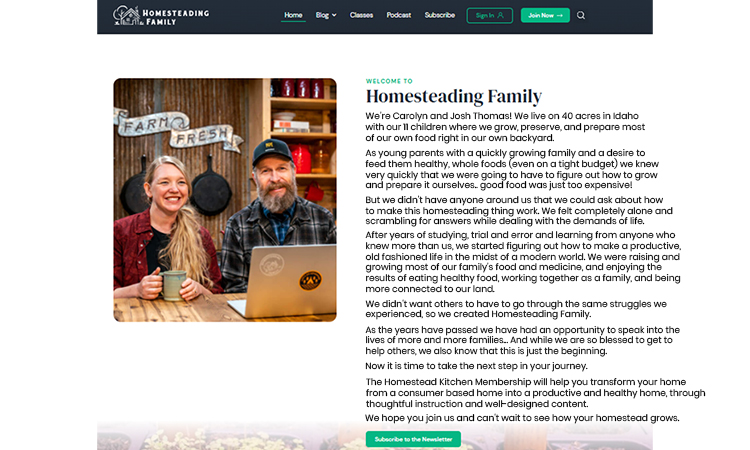
Homesteading on a 40-acre farm in Idaho is a lived experience that Josh and Carolyn Thomas of Homesteading Family share. Their advice is rooted in daily practice, reinforced by extensive content, a strong online presence (YouTube, podcast), social engagement, and media quotations. Their honesty and reputation add reliability and integrity.
- Epic Gardening

Epic Gardening shows how “experience” alone can drive Google E-E-A-T. Its founder, Kevin, shares gardening experiments, original photos, and personal tips. His practical advice and new content ideas attract huge organic traffic and search exposure, even though he doesn’t have any official credentials.
- HealthHub (YMYL Health Platform)
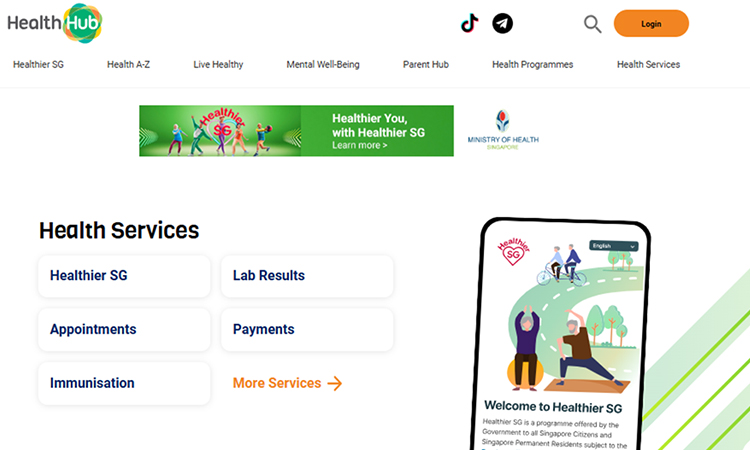
HealthHub—a health and wellness YMYL platform—leads with strong E-E-A-T by showcasing firsthand experience from contributors, credentialed authors (e.g., registered dietitians or physicians), and peer-reviewed citations. They increase authority through white papers that attract backlinks from Healthline and universities and enhance reliability via simple site structure, secure UX, and clear content moderation processes.
How Does AI-Generated Content Affect E-E-A-T Scoring?
The relationship between AI-generated content and Google’s E-E-A-T framework represents one of the most significant developments in modern SEO.
- Google’s Official Stance on AI-Generated Content Quality Guidelines
“Our focus on the quality of content, rather than how content is produced,” is still Google’s main evaluation criterion, as stated in their official position on their Search Central blog. According to the search giant, “appropriate use of AI or automation is not against our guidelines” as long as the main goal is not to change search rankings.
However, Google’s stance has evolved significantly. The quality rater guidelines have been updated to require raters to decide whether content is artificial intelligence (AI) generated. When automated content does not meet quality standards, it may receive “Lowest” ratings.
Key Policy Points:
- Quality over method: No matter the method used for production, content review puts usefulness first.
- Spam protection: AI content made mainly to change rankings breaks the rules.
- Transparency requirements: Readers should be told when they might have questions about how material is created.
- E-E-A-T compliance: All the content made by AI or humans needs to be informative, not for advertising purposes.
- Quality vs. Generation Method Priorities
Creating content in AI doesn’t get automatically penalized by Google’s algorithms, but they look at quality indicators more closely. A study of 20,000 articles confirms that “Google doesn’t directly penalize AI content,” but the platform’s expert standards are still very high.
The same E-E-A-T criteria are used to judge AI content as are used for human-written content:
- Experience verification: Does the content demonstrate genuine, first-hand knowledge?
- Expertise assessment: Are complex topics handled with appropriate depth and accuracy?
- Authority confirmation: Does the content source maintain recognized industry standing?
- Trust evaluation: Can users rely on information for important decisions?
- Human Oversight and Editing Requirements
If you want your AI-generated content to meet E-E-A-T standards, you have to do a thorough review process. So the content creators must implement—
Important Oversight Elements:
- Expert Review Process: Subject matter experts must validate accuracy and completeness.
- Experience Integration: Human editors add personal insights and real-world applications.
- Fact-Checking Protocols: Systematic verification of claims, statistics, and recommendations
- Voice and Tone Refinement: The content has to match the brand voice and expectations.
- Disclosure and Transparency Best Practices
Google recommends introducing “AI or automation disclosures to content where someone might think, ‘How was this created?'” Disclosure doesn’t harm rankings when it is executed carefully:
Effective Disclosure Strategies:
- Clear attribution: Specify AI assistance level without undermining content credibility.
- Process description: Describe how human control and expert review work.
- Focus on quality: Talk about how mistakes are checked and what the standards are for being right.
- Value proposition: Pay attention to how AI adds to human knowledge instead of taking it away.
If you want to avoid “listing AI as the author of content,” Google says that writers should “make clear to readers when AI is part of the content creation process.”
- Hybrid Content Creation Strategies
The best method uses both AI and human knowledge to make high-quality content.
Optimal Hybrid Workflow:
- AI-Powered Research: You can take help from AI for data collecting and initial content structuring.
- Expert Enhancement: Subject matter experts add knowledge, examples, and sophisticated perspectives.
- Experience Integration: Apply personal anecdotes, case studies, and practical applications.
- Quality Assurance: Multi-layer review ensuring accuracy, completeness, and E-E-A-T compliance.
Why E-E-A-T Will Become Even More Critical in the Future?
Experience, expertise, authoritativeness, and trustworthiness (E-A-T) are decisively changing the digital world. They have become the most significant ranking factor of Google to rank websites. As AI-generated content floods search results, Google’s algorithms are expanding their focus on content quality indicators to ensure user satisfaction and data authenticity.
- AI content proliferation challenges-The exponential growth of AI-generated content presents extraordinary troubles for search rankings. Nowadays, millions of automated articles are published every day, so it’s important to create content that exhibits real expertise if you want to be seen. Google’s E-A-T framework serves as the primary filter to separate high-quality content from mass-produced documents.
- Increased competition for featured snippets-Featured snippet optimization can boost click-through rates by 43%, making position zero increasingly competitive. For authoritative content, Google generally shows featured snippets; if you get one snippet, it’s easier to target others.
- User behavior shifts toward trusted sources- Nowadays, people place a higher value on reliable information sources, particularly when it comes to news, finance, and health issues. The change in behavior pushes search rankings toward websites that have proven expertise and authority. Content created by recognized experts consistently outperforms generic material in user engagement metrics, highlighting Google’s focus on E-A-T evaluation.
- Mobile-first indexing and E-E-A-T correlation- Mobile-first indexing prioritizes user experience and quick access to trustworthy information. When people use their phones, sites with strong E-A-T signals work better because they give people the quality, legitimate answers they want. In the future, when mobile traffic keeps dominating search results, this link between mobile performance and content quality will get stronger.
- Voice search and authority preference trends-Voice search is expanding rapidly, with growing consumer adoption changing how people search and shop. Voice assistants prioritize high-quality content from reliable sources when providing spoken responses. As voice search algorithms have to quickly select the most reliable source from millions of possibilities, E-A-T becomes important.
- Cross-platform authority consistency- E-A-T signals are reinforced and comprehensive authority is developed through consistent evidence of expertise across all digital platforms, which search ranking processes acknowledge and reward.
Frequently Asked Questions—Google E-E-A-T
E-A-T is Expertise, Authoritativeness, and Trustworthiness; E-E-A-T adds Experience to highlight first-hand knowledge alongside reliability.
You have to focus on creating content with clear author credentials, add specific about pages, cite authoritative sources, and regularly update existing content. E-E-A-T improvements happen faster when you get high-quality backlinks from experts in your field and show your expertise consistently on all of your web pages.
AI-generated content doesn’t automatically hurt E-E-A-T if it meets quality standards. Google evaluates content quality regardless of the creation method. However, AI-generated content needs expert review, human oversight, and proper disclosure to ensure trustworthiness and the expertise signals that quality raters expect.
Here Is Our Closing Thoughts
So at the end of our discussion of Google E-E-A-T, I can assume you have all your queries resolved. E-E-A-T is the most important ranking factor from 2022, and if you want to rank higher than other sites, you have to incorporate it into your content.
If you gain vast knowledge about Google’s search quality rater guidelines, you can input E-E-A-T on your own. If you get help from SEO professionals, though, they can give you useful ideas and tips on how to use E-A-T in your content. Their professional SEO services expertise can help your website rank higher.
So if you want to outrank your competitor’s website, you have to use E-E-A-T in SEO to improve your Google rankings.

